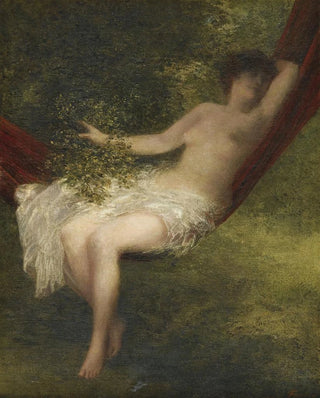Art print | Sara the bather - Henri Fantin-Latour


View from behind

Frame (optional)
In the vast panorama of art history, some works manage to capture the very essence of beauty and sensuality. "Sara the Bather" by Henri Fantin-Latour is a shining example. This canvas, depicting a woman immersed in a moment of aquatic serenity, invites the viewer to a delicate contemplation. The artist, renowned for his mastery of nuances and lighting, succeeds here in blending the softness of forms with an atmosphere imbued with poetry. The depiction of Sara, an iconic figure of feminine beauty, transcends the simple portrait to become an ode to nature and intimacy.
Style and uniqueness of the artwork
The piece stands out through its subtle use of colors and textures. Fantin-Latour, influenced by the Impressionist movement, moves away from rigid contours to offer a more fluid and organic vision. Light plays a central role, illuminating Sara's body while creating delicate shadows that add depth to the composition. The reflections in the water, carefully rendered, evoke a sense of freshness and tranquility, while the bather's posture suggests an intimate connection with her environment. Every brushstroke seems charged with emotion, revealing not only the physical beauty of the model but also a dreamlike and mysterious atmosphere.
The artist and his influence
Henri Fantin-Latour, born in 1836, is often associated with the Neo-Impressionist movement and the Parisian art scene of the 19th century. His career is marked by encounters with iconic figures such as Manet and Monet, who influenced his pictorial approach. Fantin-Latour is recognized for his still lifes and portraits, but "Sara the Bather" bears witness to his interest in the representation of the human body and feminine beauty. His work is set in a context where the depiction of women evolves, shifting from an idealized vision to a more realistic and personal approach. By highlighting the sensuality and grace of his models, the artist paved the way for a new appreciation of feminine beauty in art.

Matte finish

View from behind

Frame (optional)
In the vast panorama of art history, some works manage to capture the very essence of beauty and sensuality. "Sara the Bather" by Henri Fantin-Latour is a shining example. This canvas, depicting a woman immersed in a moment of aquatic serenity, invites the viewer to a delicate contemplation. The artist, renowned for his mastery of nuances and lighting, succeeds here in blending the softness of forms with an atmosphere imbued with poetry. The depiction of Sara, an iconic figure of feminine beauty, transcends the simple portrait to become an ode to nature and intimacy.
Style and uniqueness of the artwork
The piece stands out through its subtle use of colors and textures. Fantin-Latour, influenced by the Impressionist movement, moves away from rigid contours to offer a more fluid and organic vision. Light plays a central role, illuminating Sara's body while creating delicate shadows that add depth to the composition. The reflections in the water, carefully rendered, evoke a sense of freshness and tranquility, while the bather's posture suggests an intimate connection with her environment. Every brushstroke seems charged with emotion, revealing not only the physical beauty of the model but also a dreamlike and mysterious atmosphere.
The artist and his influence
Henri Fantin-Latour, born in 1836, is often associated with the Neo-Impressionist movement and the Parisian art scene of the 19th century. His career is marked by encounters with iconic figures such as Manet and Monet, who influenced his pictorial approach. Fantin-Latour is recognized for his still lifes and portraits, but "Sara the Bather" bears witness to his interest in the representation of the human body and feminine beauty. His work is set in a context where the depiction of women evolves, shifting from an idealized vision to a more realistic and personal approach. By highlighting the sensuality and grace of his models, the artist paved the way for a new appreciation of feminine beauty in art.






